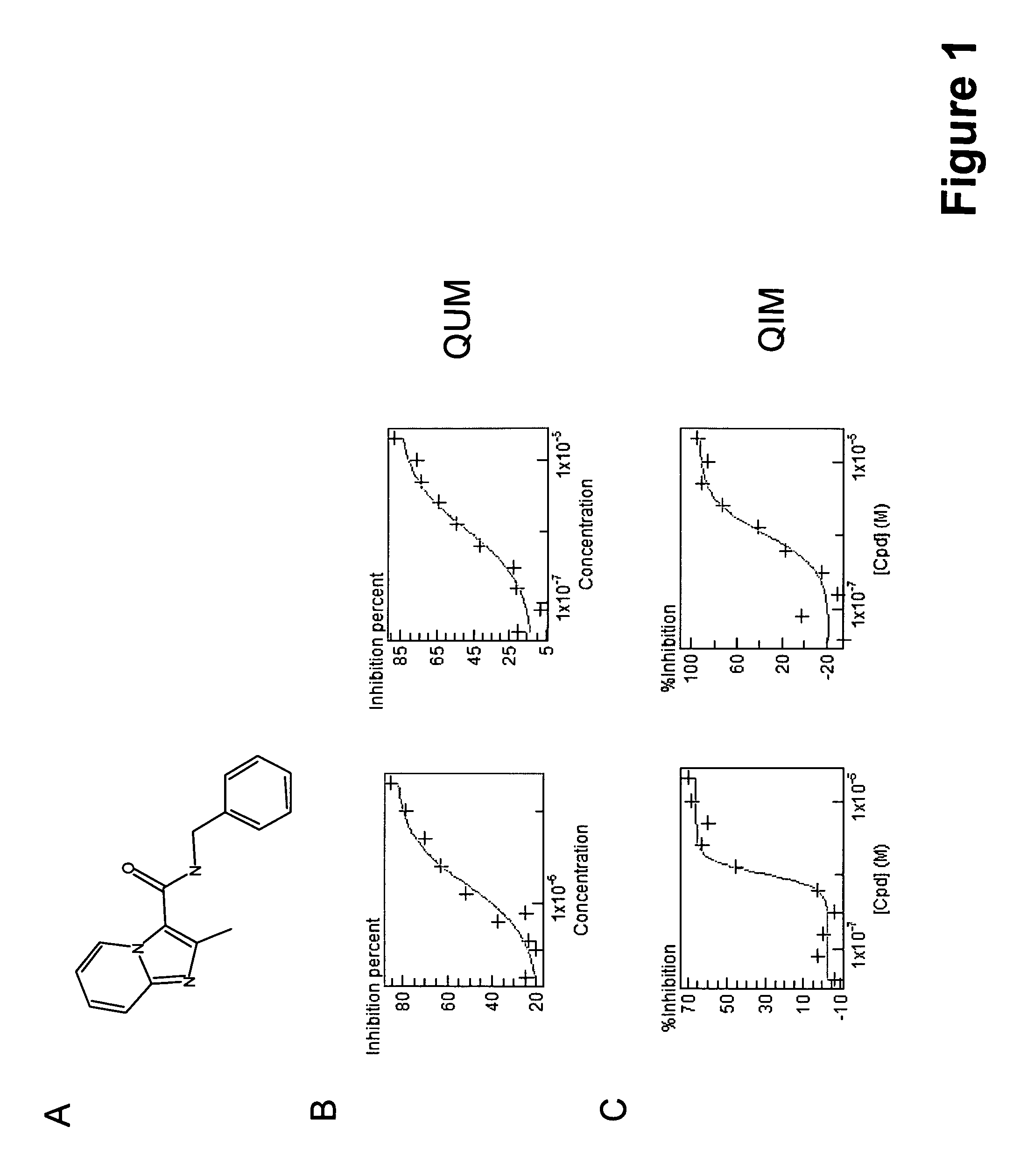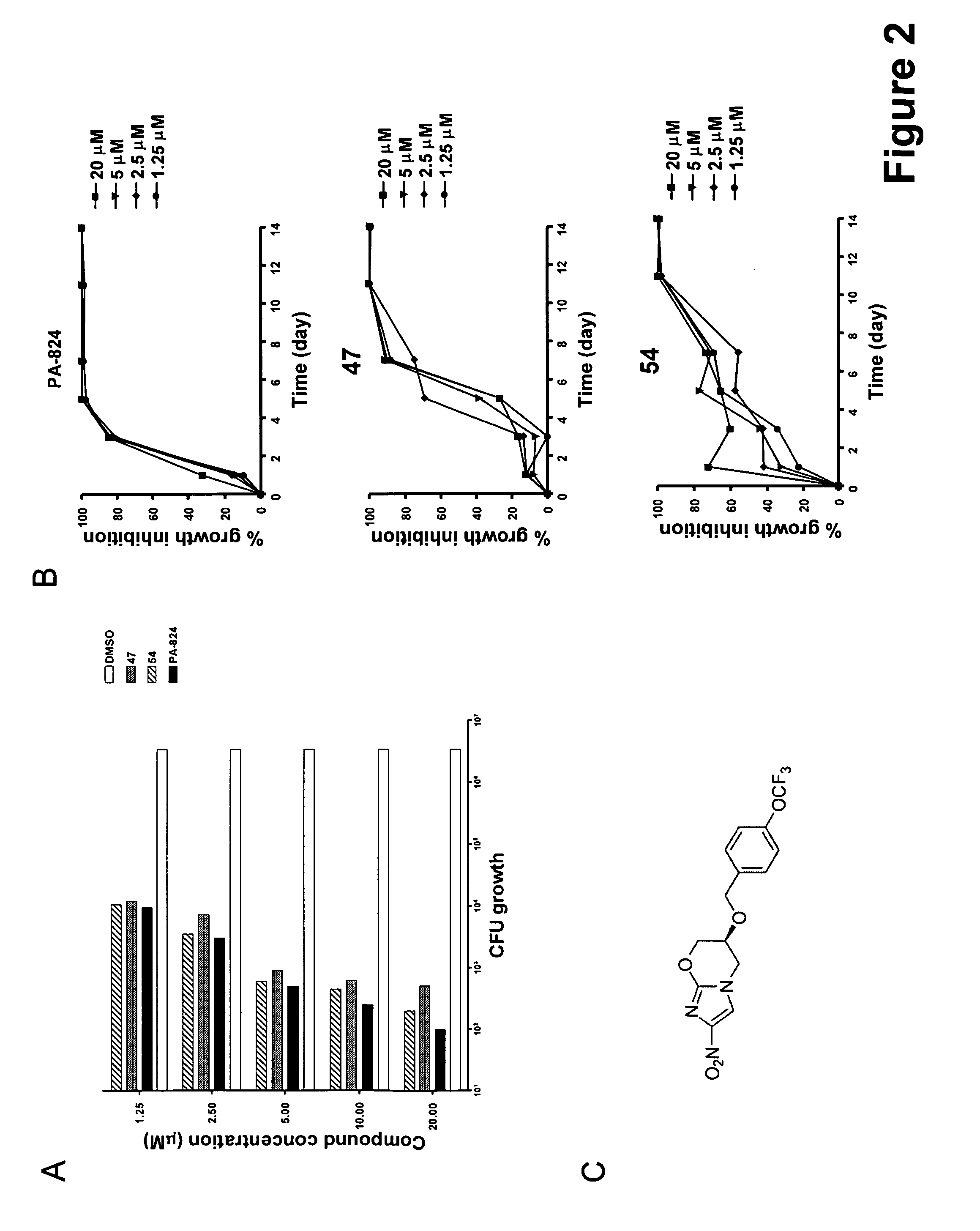Anti-Infective Compounds
a technology of anti-infective compounds and active ingredients, applied in the field of anti-infective compounds, can solve the problems of millions of deaths each year and the likelihood of worsening the situation
- Summary
- Abstract
- Description
- Claims
- Application Information
AI Technical Summary
Problems solved by technology
Method used
Image
Examples
example 1
Primary Screening of a Large Library of Small Synthetic Compounds Using the Phenotypic Cell-Based Assay
[0072]A 120,000 small molecule compound library was screened using a validated phenotypic cell-based assay (WO2010003533A2). Active compounds from the primary screen were confirmed via dose response in the intracellular (QIM) assay and an in vitro (QUM) assay, wherein the abbreviation “QIM” stands for Quantification of Intracellular Mycobacteria and the abbreviation “QUM” stands for Quantification of in vitro grown Mycobacteria. Compound 8 (FIG. 1A) demonstrated activity in both the QUM and QIM assay (FIGS. 1B and 1C respectively) and is the basis of the imidazopyridine general scaffolds Ia and Ib. Compound 8, from the dose response confirmation experiments demonstrated a minimum inhibitory concentration (MIC) or 5 μM and 2.5 μM in the QUM and QIM assays respectively. The MIC is the minimum concentration of compound required to obtain 80% bacterial growth inhibition. Compound 8 dem...
example 2
Derivatization of the Imidazopyridine General Scaffold
[0073]The imidazopyridine compounds (scaffolds Ia and Ib; see Table 1) underwent derivatization according to the methods outlined below (Schemes 1-13). Resulting derivatives were examined for inhibitory activity (MIC) using the assays described above (Example 1) and the results are summarized in Table 1.
General Procedure for the Synthesis of A1
[0074]To a solution of Ethyl propionylacetate (6.9 mmol) in Et2O (30 mL) was added Ammonium acetate (2.07 mmol) and N-Bromosuccinimide (7.6 mmol). The mixture was stirred at room temperature for 6 hour. After reaction was completed, the reaction mixture was filtered off and washed with H2O (30 mL). The organic layer was dried over anhydrous MgSO4 and concentrated in vacuo to give A1.
General Procedure for the Synthesis of A2
[0075]To a solution of A1 (0.89 mmol) in EtOH (4 mL) was added 2-aminopyridine (0.89 mmol). The mixture was stirred and refluxed for overnight. After cooling, the dark re...
example 3
Additional Studies on Imidazopyridine Compounds
Kinetics of Inhibition and Bactericidal Activity
[0823]Mycobacterium tuberculosis H37Rv was incubated at an initial inoculum of 2×106 bacteria / ml in Middlebrook 7H9 media containing an increasing concentration of representative compound 47 or 54. Culture samples were collected over a 14 day period. Serial dilutions of the bacterial suspension were performed and plated on 7H 10 medium. Colonies were counted for the different dilutions after 3 weeks incubation at 37° C. under 5% CO2 and compared to that obtained for the DMSO negative and PA-824 positive controls. PA-824 (Stover et al., 2000) is a TB Alliance small chemical compound currently in phase II clinical trials for the treatment of tuberculosis. PA-824 possibly acts via generation of radicals having non-specific toxic effects. However, the durg has been shown to inhibit mycolic acid and protein biosynthesis. In addition, PA-824 demonstrates anaerobic activity.
[0824]Bactericidal act...
PUM
| Property | Measurement | Unit |
|---|---|---|
| particle size | aaaaa | aaaaa |
| temperature | aaaaa | aaaaa |
| temperature | aaaaa | aaaaa |
Abstract
Description
Claims
Application Information
 Login to view more
Login to view more - R&D Engineer
- R&D Manager
- IP Professional
- Industry Leading Data Capabilities
- Powerful AI technology
- Patent DNA Extraction
Browse by: Latest US Patents, China's latest patents, Technical Efficacy Thesaurus, Application Domain, Technology Topic.
© 2024 PatSnap. All rights reserved.Legal|Privacy policy|Modern Slavery Act Transparency Statement|Sitemap



